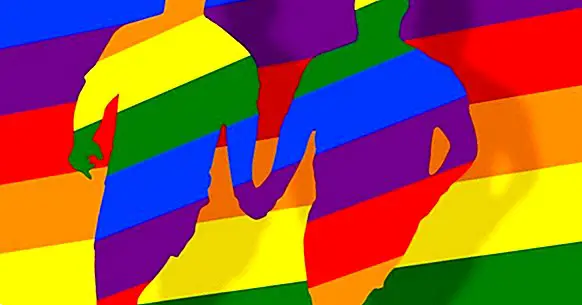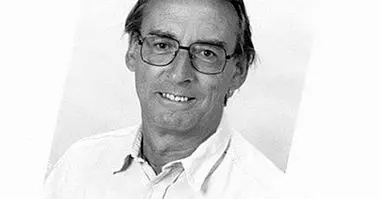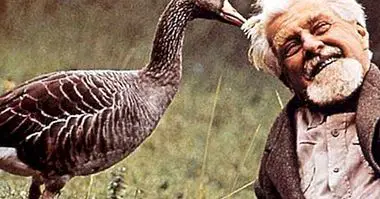The 6 theories about the causes of homosexuality (according to science)
The question about the causes of homosexuality He has been present in different discourses and scientific and philosophical investigations throughout the modern era. Heirs to the more traditional and conservative conceptions of the Middle Ages that marked the beginnings of modern science, questions about sexual "minorities" have been addressed and reformulated in an important way from different perspectives.
In this article we will briefly review some of the main scientific theories that have been asked about the causes of homosexuality . We also reflect on the implications of constantly asking about the causes of what is represented as "the different".
- Related article: "History of Psychology: authors and main theories"
On what causes do we ask?
In the year of 1973, the American Psychological Association published the second version of the diagnostic and statistical manuals of mental illness, with the intention of unifying clinical views on what is considered a disorder. In this version an important change with respect to the previous one is included: Homosexuality was removed from the compendium of disorders , with which, it was no longer considered a mental pathology.
This was only a first step, partly as a consequence of the social mobilizations of the homosexual people themselves. For its part, the world health organization withdrew homosexuality from its International Classification of Diseases until the 1990s. And it was not until the first decade of the year 2000 that the APA issued an official declaration stating that there was no scientific validity in the "corrective therapies" of homosexuality that continued to be implemented in different places.
None of these measures seems to have solved the doubts of many scientists and non-scientists about why there are non-heterosexual people (and therefore, have not completely finished with the social need to "correct" or expel).
The question about "what's different"
As is the case with other "minority groups" (in which the difference between the hegemonic groups is very important), the question about what causes this difference does not stop considering from different investigations; which, paradoxically, are constructed and present themselves as neutral.
The above is a consequence of the fact that minority groups are often stereotyped from the prejudice of danger, the malicious, the human or even the inferior. With which, it is also frequent that, when they are not made invisible, it is represented from the place of antagonism.
The above means that, a priori, many of the research questions have taken as a starting point and reference the heterosexual subject (man) and, from your body, experiences, desires, etc .; Questions about everything else have been formulated and answered.
This being the case, it is not surprising that even in professional psychology and related areas the question about the causes of homosexuality continues to be asked. To put it in other words, at the base of many research questions is a homophobic ideology often invisible. To exemplify this we could do the brief exercise of asking ourselves why nobody or almost nobody asks (neither in the research nor in the day to day), about the causes of heterosexuality.
- Maybe you're interested: "Bullying for homophobia: its harmful effects on society and education"
Theories about the causes of homosexuality
Thus, a series of investigations, with different scientific perspectives, have been developed to explain homosexuality. Next we will do a brief review of the main proposals that have taken place, from psychoanalysis to genetic and psychosocial theories.
1. Psychodynamic theories
For Freudian psychoanalysis, psychic structuring is strongly linked to psychosexual development . The sexual definition is a process that is not determined by the anatomical characteristics, but by the predominant sexual identification and the psychic choice of an object of desire. Homosexuality in this case is representative of a structuring in which a drive-by fixation has taken place towards the mother figure in opposition to the father figure.
This leads to the structuring of an object of desire that in this case corresponds to the same sex . This process does not necessarily occur in the same way in men and women. In this context, Freud used the term "inverted" to refer to homosexuality, in an attempt to establish a difference with the term commonly used: "perverted".
2. Biological determinism and genetic theories
Perhaps the theories that have had the greatest impact on studies on homosexuality have been those that they are inscribed in the biologicist paradigms . These range from Darwinian evolutionary theories to those that suggest that homosexuality is a consequence of certain genetic factors.
From the above it is usually thought that homosexuality is counterproductive for the reproduction of the species, so some research suggests that it is necessary to revise this interpretation, since the principle of natural selection does not necessarily apply in the case of heterosexuality-homosexuality .
According to some of these theories, there is the possibility of a significant increase in fertility in women with a homosexual maternal family. They have also suggested that genetic factors that are related to the X chromosome influence the homosexual orientation of men.
3. Endocrinology theories
Among the explanations above and those that follow are research and theories about endocrine activity. In these it is suggested that homosexuality is consequence of hormonal development peri or postnatal ; which in turn may be caused by different elements, for example the hormonal treatments of the mother during pregnancy.
Also these theories tend to emphasize the role of testosterone in the development of the brain and nervous system . This hormone could make the animals masculinize, especially during the gestation period. Testosterone deficits in men's perinatal development could generate male homosexuality, and high levels of the same hormone would generate female homosexuality. There are even theories that suggest that the latter is visible in the size of the fingers of the right hand; that is, according to which finger is larger than another, the hand could be an indicator of homosexuality.
Finally, and on gestational development, it has been proposed that sexual orientation is related to the immune response of the mother's body , which in turn relates to the development and activity of the Y chromosome (these theories apply when dealing with the male). Recent research has suggested that a certain reaction of the maternal body to proteins associated with said chromosome would increase the probability that the male is homosexual, as well as different medical complications.
4. Neurobiological theories
In the 1990s, the American neurobiologist Simon Levay carried out various investigations in which compared the brain structures of homosexual men and heterosexual men .
In an attempt to stop the discrimination of homosexual men (he was homosexual); the neurobiologist offered a series of answers that until today are still valid and debated.
According to their studies, there is a difference in the hypothalamus between heterosexual and homosexual men. It is a nodule that is responsible for the regulation of the endocrine system, which in the case of homosexual men has similarities with the brain of heterosexual women. To these investigations have been added different theories that suggest for example neurobiological differences in the development of men and women.
5. Biological diversity and sexual dissidence
In the context of the opening of different scientific and philosophical currents, and consequently of different social movements that advocate the recognition of sexual diversity, the queer theory has arisen. The latter assumes that both gender and sex are social constructions (consequently, sexual orientation in broad terms, it is also). As such, these constructions generate a series of norms, desires and possibilities of action; as well as practices of exclusion, segregation and pathologization .
In this same context the biologist Joan Roughgarden has taken up the Darwinian theories about sexuality, but to turn them around. Their investigations suggest the existence of different sexual genders, and questions the existence of a binary sex-gender (that is, the one that reduces to the possibility of being a man or a woman giving primacy to heterosexuality). The latter becomes visible not only in humans but in many intersex animal species and species that have the possibility of changing biological sex throughout their lives.
6. Homosexuality in other species
At the end of the 90s, Bruce Bagemihl theorizes about sexual behavior in animals and proposes that, contrary to what was believed, this behavior takes different forms, even among animals that belong to the same species. Based on his investigations, he reports that homosexual behavior of animals is visible in more than 500 species ; ranging from primates to worms, including birds and mammals from different ecosystems.
Such behavior includes copulation, genital stimulation and, in general, sexual exhibition behaviors between animals of the same sex. The same author discusses the evolutionary functions of homosexuality and proposes that they can not be the same for all species.The criticisms made towards these investigations go in the same sense, that of finding reproductive and evolutionary benefits of sexual diversity from the biological paradigms; which can also affect the disqualification of it.
Bibliographic references:
- Bagemihl, B. (1999). Biological Exuberance: Animal Homosexuality and Natural Diversity. St. Martin Press: USA.
- Skorska, M., Blanchard, R., Vanderlaan, D. P. & Bogaert, A. F. (2017). Gay male only-children: evidence for low birth weight and high maternal miscarriage rates. Archives of Sexual Behavior, 46: 205-215.
- Iemmola, F. & Camperio Ciani, A. (2009). New evidence of genetic factors influencing sexual orientation in men: female fertility increase in the maternal line. Archives of Sexual Behavior. Springer Netherlands, 38: 393-399.
- Mattioli, G. (2009). The psychoanalysts before homosexuality. Retrieved July 6, 2018. Available at //guillermomattioli.com/los-psicoanalistas-ante-la-homosexualidad/
- Lantigua, I. (2005). When homosexuality was considered a disease. The world is. Retrieved July 6, 2018. Available at //www.elmundo.es/elmundosalud/2005/06/24/medicina/1119625636.html.
- Roughgarden, J. (2004). Evolution's Rainbow: Diversity, Gender and Sexuality in Nature and People. Paperback: Los Angeles, California.
- Adkins-Regan, E. (1999). Biological Exuberance: Animal Homosexuality and Natural Diversity. Bioscience, Oxford. 49 (11): 926-82.



















